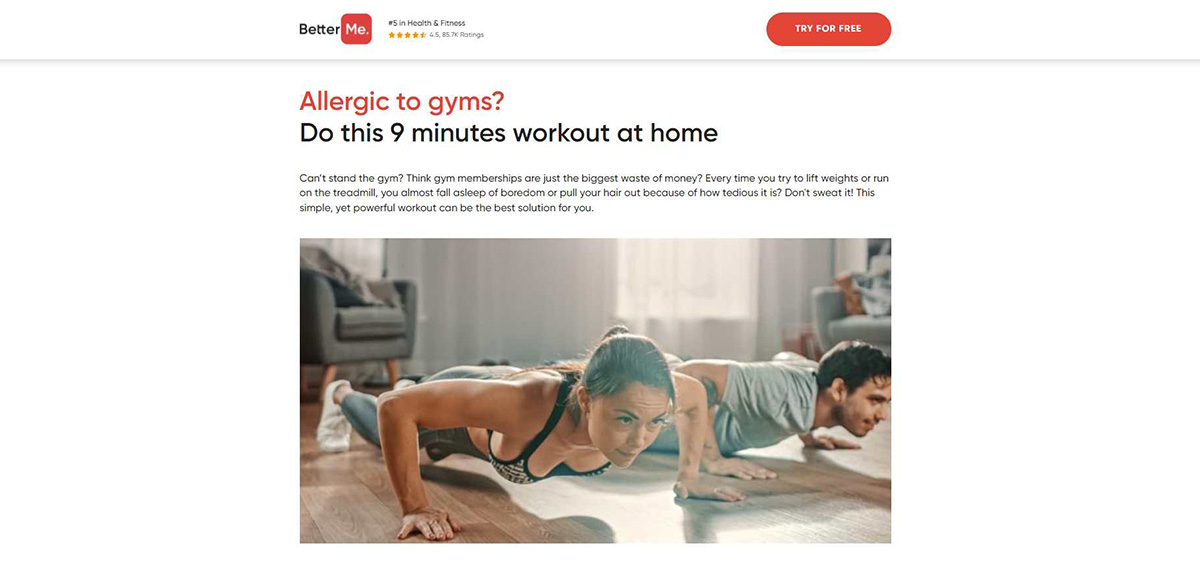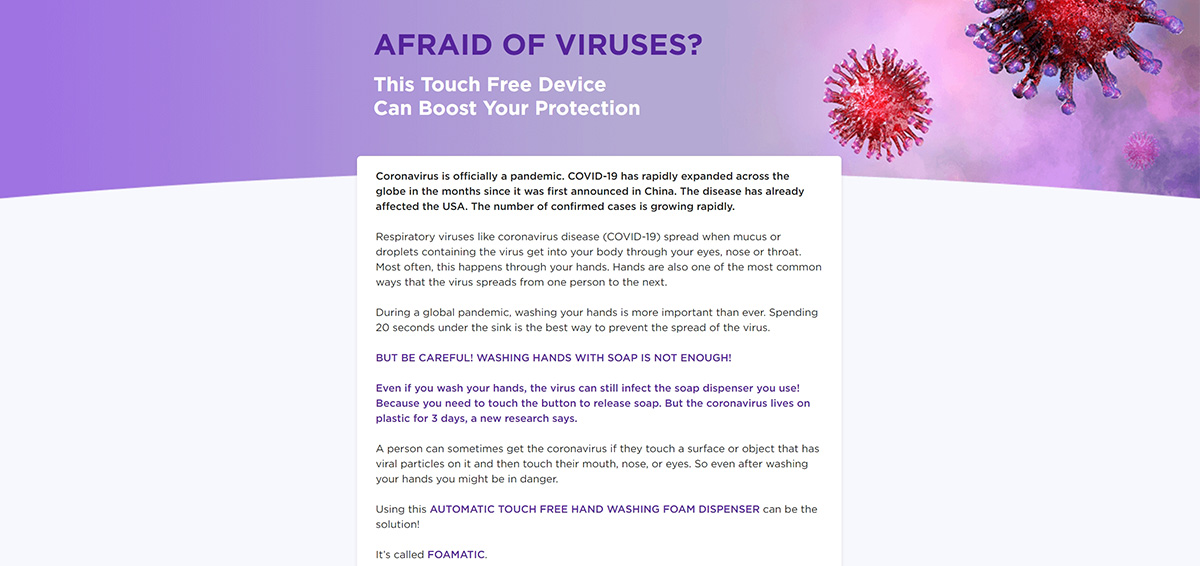The goal of any marketing funnel is to move prospects from the traffic source to the sales page and ultimately to checkout. A crucial step in this process is the bridge page. Commonly called a pre-lander, presell page or gateway page, the purpose of a bridge page is to qualify leads and “warm them up” to an offer.
When you infuse your affiliate campaign with a successful bridge page funnel, incoming prospects will not only be prepared for the sale — they’ll welcome it! In this article, you’ll learn exactly what a bridge page is, why you need it in your affiliate campaign and how you can design and implement one today.
Plus, you’ll see some real-life examples of our own bridge pages at MGID, which together have contributed to thousands of dollars in affiliate sales!
What is a Bridge Page?
A bridge page is a stepping stone in your affiliate campaign between the traffic source and the sales page. The goal of any bridge page is to qualify leads, ensure they’re a good fit for your offer and prepare them for the sale.
Without a bridge page, you’re sending cold prospects directly to the sales page before they’re ready, which is a lot like seeing someone on the street, getting down on one knee and asking them to marry you. If your goal is to scare them away, it’s a great strategy. If you’re trying to get a yes — not so much!
In this scenario, a bridge page is a lot like dating. It’s a chance to get to know one another, see if you’re well suited and make sure there’s mutual attraction before popping the question. This way, your chances of success are far greater, and you’re less likely to scare someone away.
A bridge page is an essential part of any marketing funnel, but there are several factors to consider, especially when using them for affiliate campaigns.
What is a Bridge Page in Affiliate Marketing?
When you’re setting up a native ad strategy for your affiliate campaign, you have 3 choices. The right choice for you is going to depend on your affiliate product(s), customers and campaign goals. Here are your options:
- Don’t use a bridge page
- Use a bridge page
- Use a bridge page with an email opt-in
Let’s examine each option in detail:
Option #1: Without Bridge Page

Using a bridge page is always recommended to get the best conversion rates for your campaign. However, this doesn’t mean you can’t succeed without one.
When you omit the bridge page, prospects that click on your native ads will be sent directly to a sales page. This can work — but only for what we call “wow” products.
“Wow” products are purchased solely on the strong emotions they elicit from customers, which is what entices them to buy. These emotions need to be powerful enough to make a prospect buy with only an ad and a sales page. Needless to say, these elements have to be extremely well-written and well-designed.
Another requirement for campaigns without bridge pages is the price should be relatively low. Generally, prospects aren’t likely to make an emotional purchase on a pricier item.
We recommend using the “3 hamburger rule” — if a product costs less than 3 hamburgers, you can get away with not using a bridge page. If it’s more expensive, a bridge page should be implemented.
Option #2: With Bridge Page

This is the most common strategy used by affiliate marketers to familiarize users with the brand, product and offer. With a bridge page between the traffic source and sales page, you can turn cold leads into warm leads.
At the same time, you’re separating the chaff from the wheat and getting rid of leads that won’t buy. The ones who move from the bridge page to the sales page are far more likely to take action. This means a higher conversion rate and a more effective funnel.
Aside from getting more qualified leads, bridge pages also boost engagement and click-through rates while lowering bounce rates. Since they often include interactive content like quizzes, surveys, calculators and even games, these elements help increase the amount of time prospects spend on your site engaging with your brand and learning about your offer.
As a bonus, bridge pages provide free value, which is a great way to keep people coming back to your site again and again.
Option #3: With Bridge Page + Email Opt-In

Adding an opt-in page is a great way to take your affiliate marketing campaign to the next level. The email opt-in occurs after the bridge page and serves as one more step before consumers reach the sales page.
During this step, you include a call-to-action that asks prospects to enter their email address. This will help to further qualify prospects, ensuring they’re open to an offer prior to reaching the sales page.
If a bridge page represents dating a potential partner, an email opt-in is like exchanging contact info so you can easily set up future dates. It’s an opportunity to build a long-term relationship that will benefit both parties.
Plus, there’s a huge added bonus to this strategy: when you ask prospects for their email, you can build up an email list, which you can use to send marketing messages and future offers. A strong list of warm leads can keep any affiliate business thriving for years to come.
Top 4 High-Converting Bridge Page Examples
By now, you should realize the importance of using bridge pages to optimize your affiliate campaigns. Next, it’s time to see them in action.
Below, we’ve rounded up 4 examples of high-performing bridge pages we’ve used here at MGID. All of these examples convert very well, and each has the potential to move the needle and boost sales for your own business, regardless of the product or industry.
Example 1: Advertorial — Health Supplement

Advertorials are one of the most popular — and most successful — bridge page options for affiliate campaigns. There’s a good reason why: an advertorial offers a real customer’s perspective on a product. It’s not just a review; it’s a powerful success story that conveys emotion and outlines a customer’s transformation before and after the purchase.
The below example is for a health supplement that improves vision. The speaker in the advertorial is a customer who achieved great results from using the product, and now, they’re sharing their experience. When prospects see this kind of testimonial from someone else, they’re far more likely to take action.
Advertorials are fantastic choices for bridge pages because they provide evidence of a product’s value. If you do it right, you’ll have prospects ready to place an order before they even reach the sales page.
Example 2: Online Quiz — Retirement Savings

The main benefit of using an online quiz for your bridge page is engagement. They also provide an opportunity to get to know your leads better.
When engagement is high, prospects spend more time interacting with your campaign, learning about the products and getting value from the brand. Not only will this boost conversions today but also will build long-term customer loyalty tomorrow.
The bridge page below is a great example of a well-performing online quiz for a financial service. In addition to taking the quiz, prospects are prompted to leave their email address, which salespeople can use later on to contact them with more information and additional offers.
Example 3: Calculator — Car Insurance

Much like an online quiz, a calculator bridge page gives customers a chance to interact and engage. They enter their information and get a free customized response, and that response can provide some insight into if the product or service is right for them.
In this example, prospects use the calculator to discover how much car insurance would cost them. It’s a simple, easy-to-use feature; all they have to do is enter their state of residence and age to receive an answer.
Example 4: Calculator — Car Insurance

Here’s another example of a calculator bridge page. By entering their age range and zip code, prospects can quickly see how much they can potentially save on car insurance by switching plans.
Before even reaching the main sales page, they understand the value of the product, and they know what kind of results to expect. With all this in mind, many prospects are already considering a purchase — all that’s left to do is close the deal.
See how powerful a high-quality bridge page can be?
Here’s the takeaway…
These examples of bridge pages are successful because they boost engagement, convey strong emotions, present valuable information and work to build a lasting customer relationship.
Focus on achieving these goals for your affiliate campaigns, and you’re bound to strike gold with a winning bridge page of your own.
5 Bonus Examples of Winning Bridge Pages
Looking for more ideas for your bridge page? There’s plenty of others to choose from. Here’s another 5 examples of some of our winning bridge pages.
Bonus Example 1: [BetterMe](https://creativemind.media/landing/betterme/) — Fitness App — Article

Sometimes, simplicity is best. That’s the idea behind using an article for your bridge page, which is shown in this example. The goal with an article is to provide a prospect with valuable information for free, giving them a taste of what’s to come if they buy the product on the next page. In this case, that product is a fitness app.
This article also accomplishes another goal we’ve been talking about: building a lasting relationship with the customer. When someone reads the article, they are likely to remember the brand (BetterMe) and return later for more advice. That’s how you keep a lead around for a long time!
Bonus Example 2: [Kin](https://creativemind.media/landing/kin/homeowners/) — Home Insurance — Testimonials Page

This example shows a testimonial page, which is an informative piece featuring customer reviews and positive testimonials. There’s nothing more powerful than showing real success stories to convince new prospects to take action.
There will typically be even more testimonials on the sales page, but featuring them in the bridge page will encourage prospects to continue moving through the funnel.
In this case, they’re prompted to click and get a free quote for a home insurance plan, and the customer success stories prove that doing just that is well worth it.
Bonus Example 3: [MojoHelp](https://creativemind.media/landing/instamojo/chat/) — Software — Chatbot Flow

It’s always effective if you can add some engaging, interactive elements into your bridge page. The chatbot flow strategy is perfect for this. The above example shows a chatbot flow for a company offering a new cashless payment method for small businesses.
Even though the chatbot’s answers are automated, it feels as though you’re having a real conversation. The flow leads to a calculator function where prospects can discover how much money they can make with the new method.
Bonus Example 4: [Sleepium](https://creativemind.media/landing/mantaslep/mask/) — Health — First-Person Article

This bridge page example is a first-person article from a customer for a sleep mask. This strategy is a lot like an advertorial, where it’s essentially a long testimonial describing the product’s benefits. Notice how this article seems very casual, relatable and easy to read. It doesn’t feel like a company sales pitch — it feels like a conversation you’d have with a friend.
In the article, the customer starts by talking about their problems with sleep, and how it was affecting their day-to-day life. Then, they dive into the solution that helped them: the sleep mask.
When a prospect reads this article, they’ll learn exactly what problems the product can solve, and how it can change their lives for the better. It’s a powerful persuasion tactic that can lead to a serious uptick in conversions for any affiliate campaign.
Bonus Example 5: [Foamatic](https://zestradar.com/trending/foamatic-soap-dispenser/) — Health — Article

Here’s another example of an article as a bridge page for a health product. Again, this page is clear, concise and easy to read, helping prospects move through the funnel without a hitch. At the same time, it’s informative and valuable, while introducing the product and laying out the benefits.
Another note — take a look at how visual this bridge page is. Prospects don’t want to just read about a product, they want to see it in action. The article provides this with several up-close pictures of the product.
How to Build a Bridge Page That Actually Works
If you’ve made it this far, you hopefully realize how important a bridge page is and what a successful bridge page looks like. Now, there’s only one thing left to do — build your own!
Step 1: Choose a traffic source
A successful affiliate campaign starts with a reliable traffic source. The most commonly used options are Google ads, Facebook ads and native ads. Native ads in particular are a popular choice because they blend in with existing content and media, so prospects don’t realize they’re clicking on an ad.
Step 2: Choose the bridge page format
Here are your main choices:
- Advertorials
- Quizzes
- Lead magnets (how-to articles, e-books, checklists, samples, etc.)
- Lists
- Videos
- Calculators
Step 3: Use free tools to build your bridge page
When you’ve perfected a strategy and you’re ready to build your bridge page, there are plenty of free tools at your disposal. The tool(s) you use will depend on what template you’ve chosen.
- Blogs, Articles, Advertorials: Medium or Wordpress. These tools will help you easily build a high-quality blog, article or advertorial for your bridge page. They’ll come in handy for any type of written content.
- Landing Page Builders: Leadpages. Leadpages is the top choice for small businesses building landing pages. It has a drag-and-drop interface that makes the process very quick and simple.
- Quiz/Survey Builders: Typeform or Google Forms. Typeform and Google Forms allow you to easily create quizzes, surveys and any other form to use for your bridge page.
- Calculators: Calculoid. Calculoid is a free tool devoted to creating easy-to-use virtual calculators. There are lots of different design options you can choose from, and there’s no coding needed.
- MGID Creative Team. If you’re looking for a one-stop shop to build your bridge page, our creative team offers copywriting, design and page development for free.
Moving Forward
These examples should give you a good idea of what a successful bridge page looks like. But the most important takeaway from this article is why we use bridge pages in affiliate campaigns: to turn cold leads into warm leads, build long term customer relationships and ultimately boost conversions and sales in the process.
Of course, as an affiliate, you won’t have total control over an entire campaign — but the bridge page is one aspect you can control to improve your results.
Now, it’s time to put this information to work and build a high-converting bridge page of your own. Good luck!
Need more guidance on how to become a successful affiliate? Check out our blog or explore the many other helpful resources from MGID.





